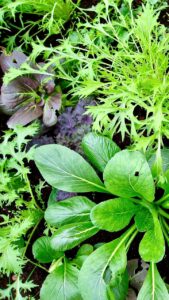Our greenhouses are transformative, regenerative and infinitely renewable. Imagine what could happen – for people, nature and planet – if we truly embraced that potential.
What if we started thinking outside of our greenhouses – the gardening equivalent of thinking outside the box? What if we could muster our collective, sun-fuelled growing power to help see us through the turbulent times ahead? What if we recognised our greenhouses as the collaborative, nature-enriching superpower they truly are?
What if there was a big, green-fingered ‘think-in’ conducted online, where everyone with anything from a cold frame to a top-of-the-range greenhouse (not forgetting the polytunnel passionistas) was able to chip in their ideas and experiences of how we could start using our greenhouses for the ecological good – while having a whole heap of home-grown, flower-filled, doom-busting fun?
What if conversations, themes and patterns then started to unfurl and bloom, showing how we could go about getting our greenhouses to flex their combined eco-muscle, to help with the heavy lifting as our nature crisis unfolds? What if our greenhouse hive mind germinated ideas and solutions we’ve not even dreamed of yet? What if we rethought, rebooted and rekindled not what our greenhouses can do for us, but what they could do together to help keep our world a colourful, abundant and less tempestuous place?

What if gardeners young and old, new and skilled, were to assemble as a seed-sowing, cutting-taking, grafting, budding, splitting, potting, planting, watering, pinching, training and harvesting eco-army – a sharing and caring community determined to unleash the untapped potential of every greenhouse in the land?
What if under-cover community gardens bloomed and seeded themselves everywhere, helping people across generations, of every hue, to rebuild their deep, but often fragile, connections with our natural world?
What if many of our greenhouses became devoted to growing as much seasonal food as possible, using only the power of the sun, helping to feed us for free, in the face of rising food prices as global heating impacts global food production?
What if… ?
What if we rounded up our greenhouses, bringing them all together in central, easily accessible places, near to where most of us live, where they could be tended, watered, shaded and ventilated by those of all ages and any abilities? What if people fell deeply in love with looking after them? And what if a crack team of retrofitting, re-glazing heroes restored and rejuvenated all the forgotten, overgrown and unloved greenhouses in the land, adding them to the growing, under-cover, sun-fuelled army?
What if every sunny (and not so sunny) wall – long, short, tall – was gifted a lean-to greenhouse, to capture and amplify the sun’s renewable riches? And what if greenhouse makers also started to think outside the sun-trapping box? What if future greenhouses were designed to run on rails (just like commercial greenhouses once did) so they could be moved between different parts of our gardens, maximising their sun-capturing potential?
And what if those dedicated under-cover growers were paid not a universal basic income, but a gardening basic income, to support their everyday, planet-healing lives? What if gardening for the good of all our earthly neighbours were what legions of us actually did, as our sun-kissed day jobs?
What if skill-sharing were central to the great greenhouse uprising, with knowledge and nous being swapped between the generations, passed from those who have gardened during the early days of tumultuous planetary change, to those just starting to sow and plant under its mounting, unsettling and unpredictable force? What if those with no space and limited means were invited to share a neighbour’s growing space?

What if… ?
What if we worked out where to focus our efforts to aid pressured nature best? What if gardens and allotments in rural towns and villages became sanctuaries for animals and insects driven from surrounding overworked, treeless and flowerless farmland? What if urban greenhouses were brimful of young plants that help sustain and boost ailing insect populations, becoming the beating hearts of buzz-filled pollinator towns and cities?
What if we started growing those young plants close to where they were to be grown on and planted out, peat-, plastic- and packaging-free, with no need for impatient white vans to deliver them? And what if they were grown not by burning the ancient, carbon-freeing sunshine bound up in fossil fuels, but with only the free and non-polluting sunshine warming our cheeks today?
What if ultra-local networks of plant breeders and seed savers took charge of the bigger greenhouses, where existing as well as new and constantly improving open-pollinated vegetable varieties could – safeguarded from chaotic and damaging weather – be reliably grown and harvested? What if these greenhouses became the trial grounds of the future, where gardening geeks tested out vegetables and flowers suited to an increasingly febrile, fluxing world?
What if… ?

What if some greenhouses became sanctuaries for nature – sheltered ports during increasingly volatile unseasonal storms? What if the cosseting conditions found in our greenhouses were used to bring on all sorts of flowers to support insect life, as our seasons become topsy-turvy and supplies of pollen and nectar run late?
What if some greenhouses glowed yellow in spring, overflowing with pots of early-flowering dandelions, their blooms ready to help sustain nectar-hungry queen bumblebees disorientated by cold, confusing and off-kilter springs? What if other greenhouses became refuges for wild lives displaced by extreme weather (or by humanity’s obsessive tidiness), where ravenous caterpillars of small tortoiseshells and red admirals could be given asylum to finish their nettle-munching in peace?
What if gardeners in areas where wild nature is held prisoner by outdated farming practices – such as the sheep-stunted uplands of Scotland and Wales – turned their greenhouses into incubators of wild plants ready to speed up nature’s recovery? What if we took onboard that such landscape-wide rewilding could only be achieved at urgent speed by engaging everyone in an unstoppable wave of citizen rewilding, rewooding and reflowering – with our greenhouses, gardens and allotments as the beating hearts of our efforts?
What if a healing tsunami of young native trees, shrubs, flowers and wild plants of all kinds spilled from our greenhouses, to be rooted by citizens in the degraded lands they call home?
What if we shook off gardening’s ‘it’s just a bit of flowery fun!’ image by showing that gardening – with each of our life-bringing greenhouses at its core – is seriously good, life-affirming news for our living world, which needs many, many helping hands?
What if… ?
Text and images © John Walker
Find John on Twitter @earthFgardener


